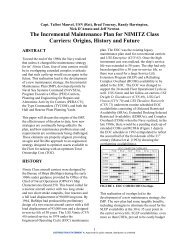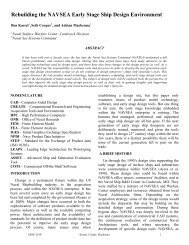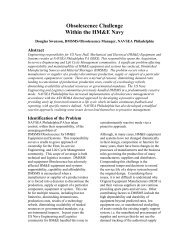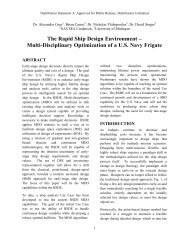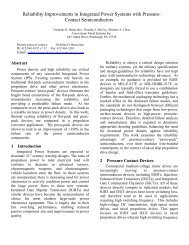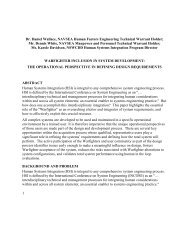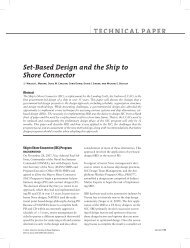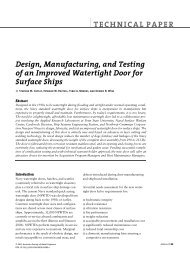The Wreck of DKM Bismarck − A Marine Forensics Analysis 1 The ...
The Wreck of DKM Bismarck − A Marine Forensics Analysis 1 The ...
The Wreck of DKM Bismarck − A Marine Forensics Analysis 1 The ...
You also want an ePaper? Increase the reach of your titles
YUMPU automatically turns print PDFs into web optimized ePapers that Google loves.
<strong>The</strong> <strong>Wreck</strong> <strong>of</strong> <strong>DKM</strong> <strong>Bismarck</strong> <strong>−</strong> A <strong>Marine</strong> <strong>Forensics</strong> <strong>Analysis</strong><br />
patches over the entrance and exit holes to repair the damage at the bow. <strong>The</strong> plates to cover the<br />
entrance and exit holes were cut and ready to install. This plan was rejected by Admiral Lütjens,<br />
as it would involve slowing the ship and creating a list to port or starboard to permit the repairs.<br />
From pictures, it appears the bow was down 1.5 to 2.5 meters, so one could anticipate a<br />
commensurate rise at the stern. In fact, the underside <strong>of</strong> the stern was clear <strong>of</strong> the water in one<br />
picture. Survivor accounts say the starboard screw was running with its blade tips out <strong>of</strong> the<br />
water after the 24 May battle.<br />
Captain Lindemann ordered the flooding <strong>of</strong> starboard voids in Compartments II and III in<br />
the stern to restore trim and list, but it is unknown how effective this was. Presumably, trim was<br />
not fully restored. Unfortunately, these counter flooding measures increased draft and decreased<br />
the overall freeboard. This could have been a factor in later events, since a lower freeboard<br />
meant less reserve buoyancy. A lower freeboard made it more difficult to hit below the main<br />
side belt when firing at close range. Close-range gunfire is more likely to have shells ricochet <strong>of</strong>f<br />
the water surface, substantially reducing the likelihood <strong>of</strong> shells having an underwater trajectory.<br />
THE CHASE ─ 24 May through 26 May 1941<br />
<strong>Bismarck</strong> was hit by one torpedo dropped by a Swordfish torpedo bomber launched from<br />
HMS Victorious the evening <strong>of</strong> 24 May. This contact detonation, on the starboard side in way <strong>of</strong><br />
the 320-mm main side belt armor was not a factor in the ultimate destruction <strong>of</strong> the German<br />
This minor damage on the starboard side amidships was caused by an aerial torpedo the evening <strong>of</strong> 24<br />
May 1941. <strong>The</strong> torpedo detonated against the 320-mm main side belt armor, failing to penetrate. <strong>The</strong><br />
gouges in the upper (145-mm) and main side belts are from hits by 203-mm or smaller caliber shells<br />
that did not penetrate.<br />
12



